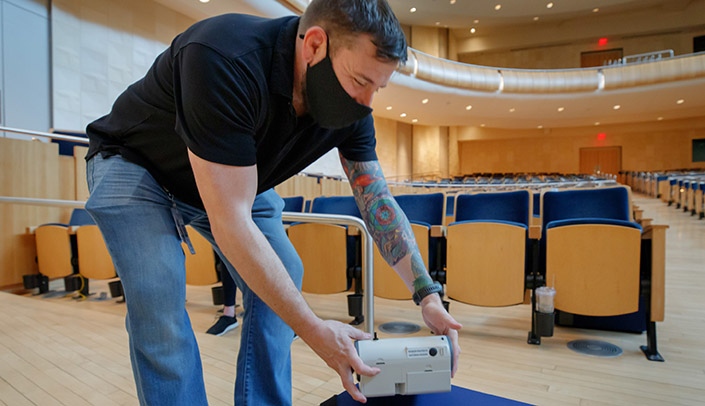Hope is in the air.
Organizers at the Omaha Symphony hope to safely return more musicians on stage this fall and have partnered with UNMC to study air particles to determine the feasibility.
The idea for the study started with a conversation between UNMC Chancellor Jeffrey P. Gold, MD, and Omaha Symphony President and CEO Jennifer Boomgaarden. Dr. Gold serves on the board of the Omaha Symphony.
“Dr. Gold is a fantastic resource for us,” said Anwar Nasir, chief revenue and advancement officer of the Omaha Symphony. “He’s an amazing connection to help us in the time we’re in now. He’s helped us get connected to the appropriate resources.”
Nasir said their first safety plan, conducted with Omaha Performing Arts, enabled them to return to performances last October on a limited basis with 40- to 46-member ensembles. Normally, ensembles range between 75 and 90.
“We’re planning for our next season and asking what we need to be thinking about to continue keeping everyone safe as we move forward,” Nasir said. “We closed around March 2020 like most organizations and businesses. Throughout our limited capacity re-opening this fall, we’ve been following all the safety and health protocols of the Douglas County Health Department.”
He said the first plan enabled them to put brass players in the balcony instead of on the main floor, because the air system goes up and not out.
A UNMC team led by Josh Santarpia, PhD, recently started its preliminary work. He and graduate student, Sarah Stein, used portable optical particle sizers to collect air particles to measure the size and concentration level of particulates in the air both during an orchestra practice and when the auditorium was empty.
“We got some good data around the orchestra practice, and some good data when it was empty. It’s a good start to understanding the system,” said Dr. Santarpia, an associate professor in the UNMC Department of Pathology and Microbiology.
Before the pandemic, Dr. Santarpia and others were engaged in biodefense studies. They’ve done air studies in COVID-19 with quarantined individuals from the Diamond Princess cruise ship, hospitalized patients, and in commercial and military aircraft, as well as in the cruise industry.
“COVID has been an interesting reapplication of a lot of the work we’ve done over the past 15 years,” he said.

Great story, Vicky. Very interesting.